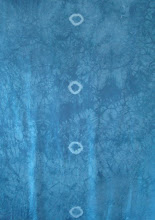
Decided to wait a bit before diving in, and “listen” to the cloth. Did some research on Mixing Blue 402c, and learned it should discharge to a grey. This should be good. I did a test, and it discharged completely, to a wonderful white. You definitely knew what you were doing when you pre dyed our pieces with this Mixing Blue. Fantastic – got to get me some of this stuff from Pro Chem. Knowing it will go white, anything could happen.
After a week of listing possibilities and ideas, and generally procrastinating … I decide to let the elastic band marks guide my start. I also decide that I want to respect the original blue in some way, so must enable some of it to shine through. Using my husband’s glass marble collection, and some old golf balls of my dad’s … I elastic band wrap lots in a zig zagging swirl down the middle area, and then position 4 golf balls in outer edge areas. 186 marbles, 4 golf balls …Then a quick discharge bath in thiox, and ….

Now what? Cloth started blue, so I figured complementary oranges might be a nice place to start. Listen to the cloth.
I arranged the white bound silk in the largest plastic tray I could find in our basement. Lucky for me, I already owned something big enough to lay 2 m of cloth into. Next step was going to be tray dyeing, using some basic primary MX: Pro Chem Golden Yellow 104, and Pro Chem Mixing Red 305. Used 1 tsp powder dye in 1 c of water, to make a simple concentrate solution.

Blue outlines I had expected, but the blending of golds, oranges to reds, ended up being much stronger and brighter than I had expected. On cotton, these basic primaries are much more toned and less in your face. What did I expect? Silk is not cotton.
Lots of possibilities to overdye, add more bound shapes? Decided to use some even smaller glass beads to elastic bind into areas. To widen and thicken the curves of the zig zag. Elastic bound these. Then, soda soaked the cloth in 9 T soda ash, plus 1 gal water. 20 minutes. Squeezed out excess. Arranged back into the large tray. Only wanted to drip drop various dyes over top of the new bound beads, and some over the edge red areas. Used 1 tsp Pro Chem ProIntense Blue 406, in 1 c water. Dripped and eye dropper dropped. Covered tray, batched overnight. Rinsed well.Hmm … got the little squares and some nice soft blue in the original squares. But the red didn’t soften as I had hoped.

Asked a few dyer friends about silk and dye saturation points … none really had experienced this. Hmm … maybe it’s the soda soaking? I really want to darken those edges. So … against the odds, I re tried the soda soaking, using a 3 T Maiwa Brown in ½ c water concentrate. This was a super dark concentrate. Tray dyed again, and poured and spooned concentrate directly over areas I wanted darker. Batched 8 hours. Was looking great in the tray. Rinsed. Oh no….. most of the beautiful darkness washed down the drain. Cloth had darkened a bit, but not like it should have. Boo hoo. Well, now what? Looks as though using dye was out of the question. Would need to start using fabric paints.
Maybe potato dextrin texturing might be interesting. That way I could paint in dark Setacolour into the crackles, and darken in a subtle manner. Never tried potato dextrin before, but was willing to try it to get those wonderful organic crackles. Just happened to have a bag in the cupboard. It’s surprising what one accumulates over time. I forged ahead with the application. It dried with great cracking and veins. Sure hope this works – had to wait 2 days for it all to dry on the dining room table. Once dry, I even crumbled everything up and made even more cracks into cloth surface by squeezing it all up tightly. Had just received the latest Quilting Arts issue, and couldn’t believe it when I saw your article about flour mixtures over cloth. As I waited for my “potatoes” to dry, I marveled how coincidental the timing of your article seemed.

Hard to believe that with all that dark paint, only these light cracks showed through. Now how am I going to darken areas I want darker?

Guess I’ll have to resort to printing or screening. I’m not very skilled at either, and seem to make blobs in unwanted spots, but what choice do I have? Made up some potential thermofax screen images – photocopies of elastic bound marbles, done in soft swirls and curves. Looked OK, crisp copies. Oh Oh, tattoo shop closed – staff gone on holidays. They’re the only shop nearby with a thermofax machine. I’m just going to make stamps and print areas darker.
Once cloth dry, I brushed Opaque Setacolour firmly and harshly into the cracks and over dextrin surface. A mix of Raw Sienna and Black – a great dark brown. This better work. Edges were now very dark brown. Let it rest 24 hours, as I was now running out of time to finish this whole challenge. Soaked, rinsed, soaked, rinsed. Only minor cracking marks emerged. So sad … the veining is definitely interesting, but not enough to truly give the effect I had sought. When and if I use dextrin again, I’m going to begin at the white, flat cloth stage, and really go to town with the cracks and use pure black Setacolor. Feeling the push to finish. It’s now Feb 15th and the cloth needs to be mailed by the 23rd. So …. using Colorhue Brown, mixed with some Scarlet and water, I begin darkening.
First the cloth was misted with water, to dampen. Then, using a natural sponge, I begin to sponge on the browns. Maybe now this darkness will stay in the cloth. Woops, the phone rings and I make the mistake of answering it and talking for several minutes. I’m too late to remist with water and soften the sponge marks. What’s to be, is to be. Oh well, at least things are darker nowI then added even more printed squares around the edges. But that lower golf ball square is looking odd and lost. Hmm … What to do? I decide to discharge it using Jacquard Paste and then change its colour. Something to counter or provide more balance and tension to the upper three squares? The discharge paste works fine, and lightens it to a soft yellow – but then I remember, everything now needs to be washed thoroughly to remove the paste residue, before recolouring. There’s no turning back … so I fill the sink, and in goes the cloth. I hold my breath, and …thank goodness, no colour bleeds out. I am so lucky. I let everything dry overnight, and re pin to printing board to add more printed sponge squares.
I begin to colour in the lightened larger lower square with Caran dAche Neocolor II water soluble crayons. Trying to create a similar turquoisy blue as in the centre swirl. Maybe this will be OK, but I need to let it dry. Tomorrow will be my last day being able to work with the cloth. It’s got to get in the mail.
Things looked OK dry – so I added just a very few more printed squares before I went to work. This was it – I knew it had to dry during the day to allow me to iron and package for tomorrow. What I’ve created is not truly finished, but all I can do given the time at hand. I would love to keep darkening the edge areas, maybe with more Colorhue? More printing? I’d love to add some foiling – a glimmering swirl down the centre, with a few sparkles throughout the outer areas. Maybe even some Shiva rubbing texture?
Conclusion: Oh well. Enough is enough, I have to get things mailed off to reach Texas in time for the Mar 1 due date. I am happy with some areas, but disappointed in many. It’s not quite what I had envisioned, but it’s the best I could I do. I am not an expert at any of these techniques, just a fearless adventurer who loves to play.







































